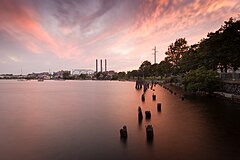India Point Park
| India Point Park | |
|---|---|
 |
|
| Location | Fox Point, Providence, Rhode Island |
| Coordinates | 41°49′03″N 71°23′33″W / 41.8176003°N 71.3925556°WCoordinates: 41°49′03″N 71°23′33″W / 41.8176003°N 71.3925556°W |
| Area | 18 acres (73,000 m2) |
| Created | 1974 |
| Visitors | 75,000 |
India Point Park is a park in the Fox Point neighborhood of Providence, Rhode Island at the confluence of the Seekonk River and Providence River. The park takes its name from the maritime activity connecting Providence with the East and West Indies. The East Bay Bike Path begins at the eastern end of the park, and crosses over the Washington Bridge before heading to Watchemoket Square in East Providence and continuing on to Bristol and the Mount Hope Bridge. The park is also a part of the Washington–Rochambeau Revolutionary Route.
India Point was Providence's first port. It was established in 1680 and flourished as a center of maritime trade for 250 years.John Brown established his tea and spice trade with the East Indies here, which is what gives the park its name. India Point Park remained an important trade center until the Great Depression.
During the early 1800s, Fox Point became a major transportation center for the city, serving as many as seven steamship lines. In 1835 a railroad opened on India Street at Ives Street.
During the 19th century, Providence was growing some of the largest manufacturing plants in the country, including Brown & Sharpe, Nicholson File, and Gorham Silverware. Many of these companies shipped their goods through the wharves at India Point. Providence shipped out cotton and woolen goods, hardware, machinery, steam engines, and other goods to the world. In return, the ships brought raw materials including cotton, wool, leather, iron, hides, and other products. By the late 1800s the ships were bringing coal to Providence. In 1878 coal imports peaked at nearly one million tons of coal, which were stored in storage yards and wharves along the harbor. Many of these wharf pilings were still visible a century later.
...
Wikipedia
